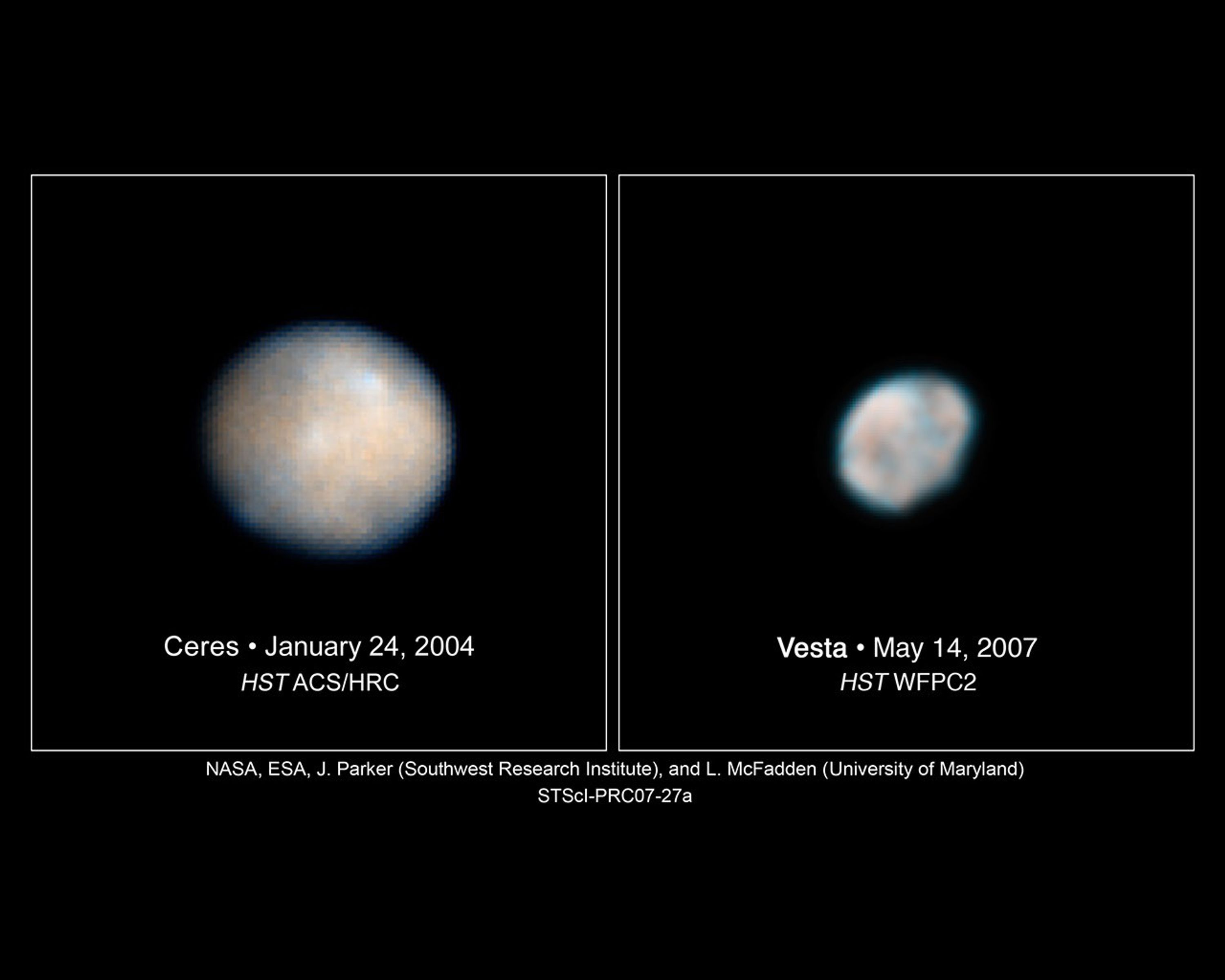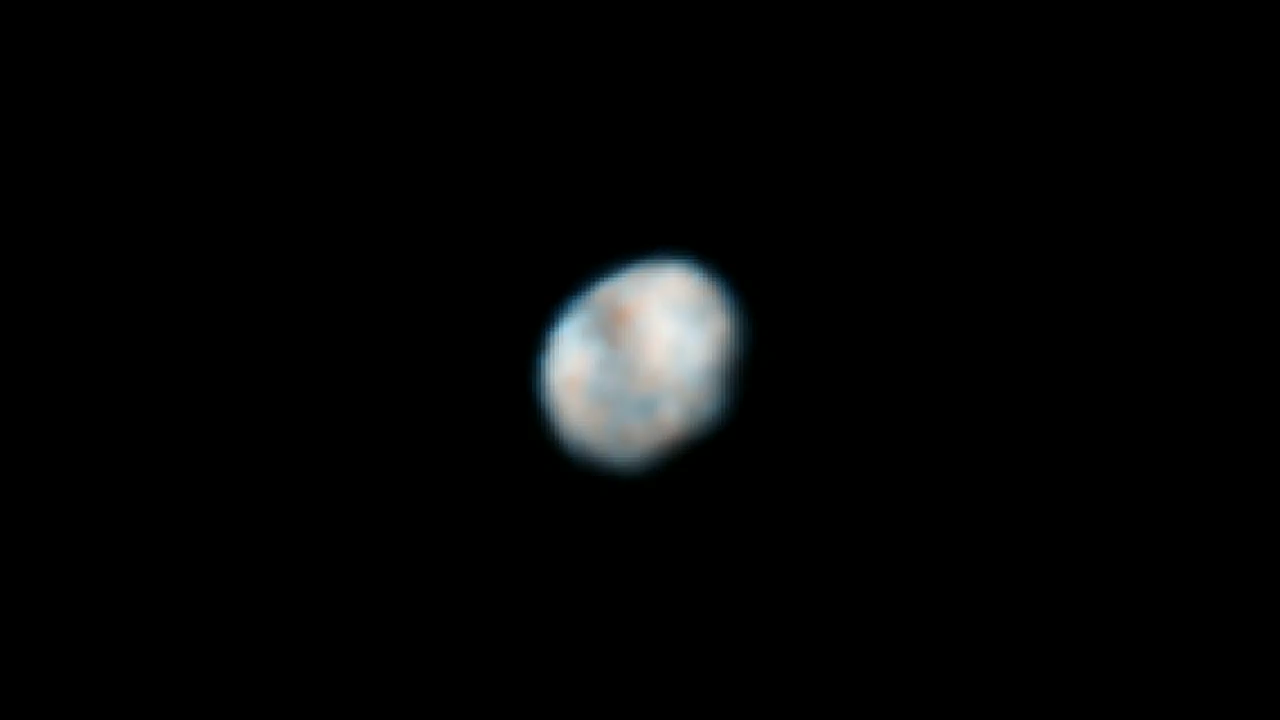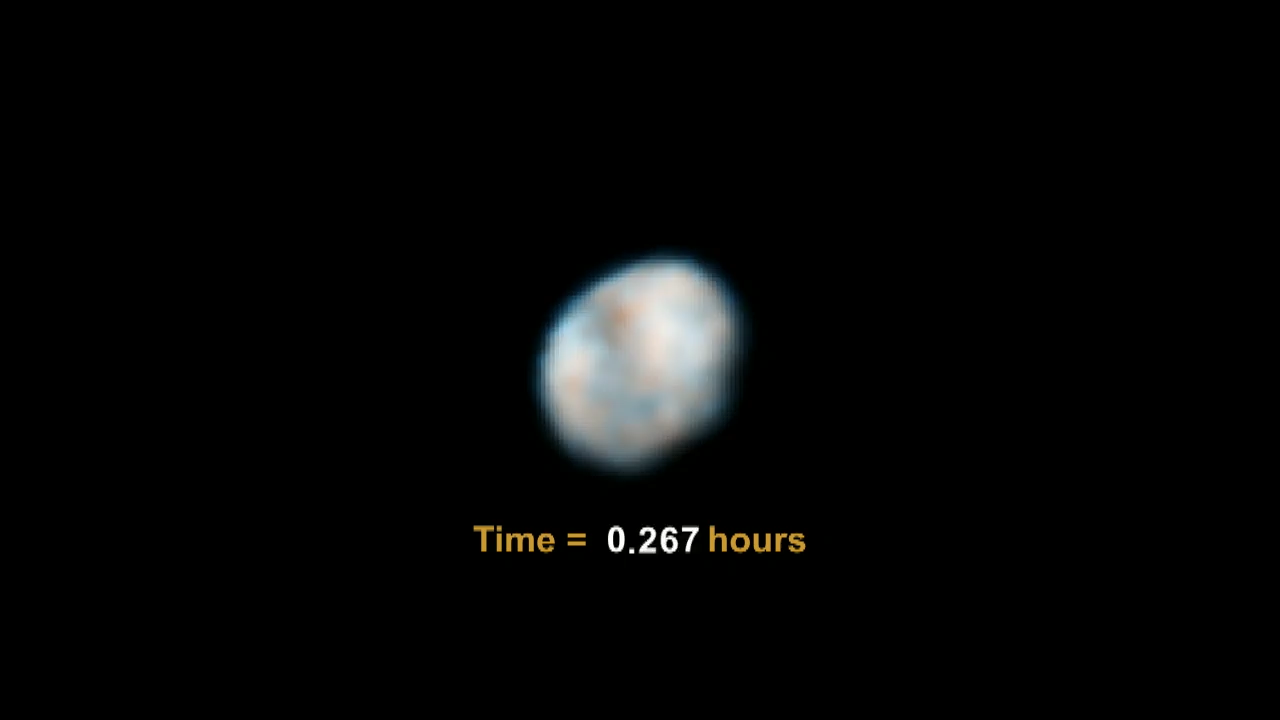These Hubble Space Telescope images of Vesta and Ceres show two of the most massive asteroids in the asteroid belt, a region between Mars and Jupiter. The images are helping astronomers plan for the Dawn spacecraft's tour of these hefty asteroids.
On July 7, NASA is scheduled to launch the spacecraft on a four-year journey to the asteroid belt. Once there, Dawn will do some asteroid-hopping, going into orbit around Vesta in 2011 and Ceres in 2015. Dawn will be the first spacecraft to orbit two targets. At least 100,000 asteroids inhabit the asteroid belt, a reservoir of leftover material from the formation of our solar-system planets 4.6 billion years ago.
Dawn also will be the first satellite to tour a dwarf planet. The International Astronomical Union named Ceres one of three dwarf planets in 2006. Ceres is round like planets in our solar system, but it does not clear debris out of its orbit as our planets do.
To prepare for the Dawn spacecraft's visit to Vesta, astronomers used Hubble's Wide Field Planetary Camera 2 to snap new images of the asteroid. The image at right was taken on May 14 and 16, 2007. Using Hubble, astronomers mapped Vesta's southern hemisphere, a region dominated by a giant impact crater formed by a collision billions of years ago. The crater is 285 miles (456 kilometers) across, which is nearly equal to Vesta's 330-mile (530-kilometer) diameter. If Earth had a crater of proportional size, it would fill the Pacific Ocean basin. The impact broke off chunks of rock, producing more than 50 smaller asteroids that astronomers have nicknamed "vestoids." The collision also may have blasted through Vesta's crust. Vesta is about the size of Arizona.
Previous Hubble images of Vesta's southern hemisphere were taken in 1994 and 1996 with the wide-field camera. In this new set of images, Hubble's sharp "eye" can see features as small as about 37 miles (60 kilometers) across. The image shows the difference in brightness and color on the asteroid's surface. These characteristics hint at the large-scale features that the Dawn spacecraft will see when it arrives at Vesta.
Hubble's view reveals extensive global features stretching longitudinally from the northern hemisphere to the southern hemisphere. The image also shows widespread differences in brightness in the east and west, which probably reflects compositional changes. Both of these characteristics could reveal volcanic activity throughout Vesta. The size of these different regions varies. Some are hundreds of miles across.
The brightness differences could be similar to the effect seen on the Moon, where smooth, dark regions are more iron-rich than the brighter highlands that contain minerals richer in calcium and aluminum. When Vesta was forming 4.5 billion years ago, it was heated to the melting temperatures of rock. This heating allowed heavier material to sink to Vesta's center and lighter minerals to rise to the surface.
Astronomers combined images of Vesta in two colors to study the variations in iron-bearing minerals. From these minerals, they hope to learn more about Vesta's surface structure and composition. Astronomers expect that Dawn will provide rich details about the asteroid's surface and interior structure.
The Hubble image of Ceres on the left reveals bright and dark regions on the asteroid's surface that could be topographic features, such as craters, and/or areas containing different surface material. Large impacts may have caused some of these features and potentially added new material to the landscape. The Texas-sized asteroid holds about 30 to 40 percent of the mass in the asteroid belt.
Ceres' round shape suggests that its interior is layered like those of terrestrial planets such as Earth. The asteroid may have a rocky inner core, an icy mantle, and a thin, dusty outer crust. The asteroid may even have water locked beneath its surface. It is approximately 590 miles (950 kilometers) across and was the first asteroid discovered in 1801.
The observations were made in visible and ultraviolet light between December 2003 and January 2004 with the Advanced Camera for Surveys. The color variations in the image show either a difference in texture or composition on Ceres' surface. Astronomers need the close-up views of the Dawn spacecraft to determine the characteristics of these regional differences.
BACKGROUND INFORMATION: A PLANET BY ANY OTHER NAME – WHEN CERES AND VESTA WERE PLANETS
Pluto's demotion from the list of solar system planets grabbed front-page headlines in 2006. But the debate over the qualifications for planethood reaches back to the early 1800s when astronomers spotted an object called Ceres.
Guiseppe Piazzi at the Palermo Observatory spied Ceres in 1801 in a gap between Mars and Jupiter where a planet was expected to reside, based on the spacing of the known planets in the solar system. Known as the Titius-Bode Law, this prediction was named for the astronomers who had noticed in the 1760s and 1770s that the relative distances of the six known planets from the Sun fit a mathematical relationship. Although it is called a "law," it has no basis in physics.
According to Titius-Bode, a planet should exist between Mars and Jupiter. Astronomers had been hunting for this phantom planet since Uranus was discovered in 1781. Uranus, too, was at just the distance where the law predicted a planet should be.
Nestled between Mars and Jupiter, Ceres was in just the right spot, too. So astronomers called it a planet. Piazzi initially named the new planet Ceres Ferdinandea after the Roman goddess of the harvest and King Ferdinand IV of Naples and Sicily. Ferdinandea, however, was later dropped.
Ceres's discovery was just the beginning of a landslide of small bodies spotted between Mars and Jupiter. A year after Ceres was discovered, astronomers found another body between the two planets that was almost as bright as Ceres. Heinrich Olbers unexpectedly found the second body, which he called Pallas after Pallas Athena, an alternate name for the goddess Athena.
Many astronomers realized that neither Ceres nor Pallas fit the conventional idea of a planet because their disks were so small they could not be resolved through telescopes. Because of their star-like appearance, Sir William Herschel coined the term "asteroid" for such bodies, writing in 1802: "They resemble small stars so much as hardly to be distinguished from them, even by very good telescopes." Herschel, therefore, argued that Ceres and Pallas were different from other planets.
Most other astronomers, however, disagreed. These two new additions to the solar system were listed with the rest of the planets.
The gold rush of small bodies continued to pile up. Astronomers nabbed Juno in 1804 and Vesta in 1807. The growing list of small objects raised concern that the asteroids were debris from a planet that had somehow disintegrated. Nevertheless, Juno and Vesta joined Ceres and Pallas as planets.
By the 1820s, astronomers counted 11 planets in the solar system. Introductory astronomy texts of that time listed the planets as Mercury, Venus, Earth, Mars, Vesta, Juno, Ceres, Pallas, Jupiter, Saturn, and Uranus.
Astronomers found another body, Astraea, near the end of 1845, almost 39 years after Vesta was spied. Three new objects were spotted in 1847. By the end of 1851, there were 15 known bodies between Mars and Jupiter.
Finally, astronomers realized that this large number of similar bodies all in orbit between Mars and Jupiter represented a new class of solar-system object. They called them asteroids, the name Herschel had coined 50 years earlier. Instead of listing them by distance from the Sun, as they did the planets, astronomers categorized them by their order of discovery. Astronomers today list about 100,000 known asteroids as large as 6 miles (10 kilometers) across located between Mars and Jupiter, a region now called the asteroid belt.
So Pluto's dismissal from the planetary ranks is not unique. Ceres, Vesta, and the other asteroids found in the 1800s, suffered the same indignity. In fact, their stories are similar. Astronomers began to question the planethood of Ceres, Vesta, and the other asteroids as they spotted more objects in the same region. Likewise, Pluto's planetary pedigree was put to the test when astronomers began finding other icy rocks in the planet's neighborhood, a region now called the Kuiper belt. In fact, one of the objects discovered, Eris, is even larger than Pluto. Ceres, Vesta, and Pluto also are among the most massive bodies in their respective regions, the asteroid belt and the Kuiper belt.
In 2006, the International Astronomical Union (IAU), an astronomers' professional society, attempted to settle the ongoing debate by adopting a new planet definition. According to the IAU, a planet is an object that orbits a star, is large enough to have settled into a round shape, and dominates its orbit. The newly adopted definition was bad news for Pluto but good news for Ceres. Pluto was demoted to a new category called dwarf planets, and Ceres was promoted to the same category. Dwarf planets share some, but not all, of a planet's characteristics. Both bodies are round like planets but do not clear out their orbits of debris.
The long debate on the definition of a planet is a textbook example of how scientific concepts are not etched in stone but continue to evolve with new discoveries.
The Dawn spacecraft traveling to Vesta and Ceres and the New Horizons satellite heading to Pluto may help clarify the debate by delivering close-up views of these objects.


































